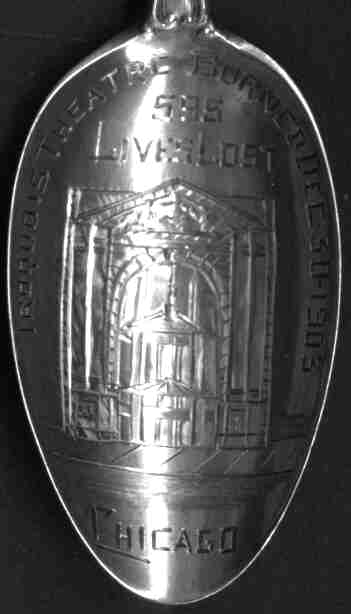
This engraved spoon reads
"Iroquois Theatre Burned- Dec 30 1903- 595 lives lost -Chicago"
On page 224 (plate #568) of my book Collectible Souvenir Spoons I showed the above picture of an engraved spoon by the Mechanics Co (Watson souvenir division).
The amount and quantity of information available on the WWW is absolutely staggering. I entered the term Iroquois Theater Chicago into one of the search engines and the following highly informative article popped to the top.
“1903, December 30: Iroquois Theater Fire
Chicago's most deadly fire occurred less than a month after the opening of the new,
supposedly fireproof Iroquois Theater at 24-28 W. Randolph. It was standing room only
for a holiday matinee of the popular musical "Mr. Blue Beard, Jr." Of the 1,900 people in
the audience, mostly women and children, at least 600 perished. Among the 500
performers and backstage personnel, only the tightrope artist caught high above the stage
died.
Due to a long history of theater fires in the U.S. and Europe, by 1903 fire precautions
were well developed, but not followed by the Iroquois Theater management. The primary
danger came from the stage scenery consisting of many canvas backdrops painted with
highly flammable oil paints and suspended in midair close to a large number of hot lights.
In a number of fatal fires, including the Iroquois the scenery caught fire, then quickly
reached almost explosive proportions.
Standard precautions which had functioned well in other localities included firemen
stationed near the stage with fire extinguishers, hoses and pikes for pulling down scenery.
In case of fire, an asbestos or iron curtain would drop down cutting the audience off from
the stage and its burning scenery. Adequate exits and trained ushers would prevent deaths
from panic.
Neglect of all of these factors contributed to the huge death toll in the Iroquois Theater
fire. At 3:15 p.m. a hot light started flames crackling up a velvet curtain. The on-duty
fireman was equipped only with two tubes of patent powder called Kilfyres. Sprinkling
these on the fire proved totally ineffective. The theater lacked fire hoses, extinguishers or
any other means of fighting fires above the fireman's head.
The asbestos fire curtain got stuck before it reached the full down position due either to
projecting lamps or cheap wooden tracks. This left a gap which exposed the audience to
flame and smoke. The curtain was apparently instantly consumed in the fire anyway.
Testimony revealed that the curtain was probably not made of a fire proof material.
Curtain reinforcements as well as the tracks in which it rode were cheaply constructed of
wood leading to probable failure in a fire. The inexperienced stage crew was slow to pull
down the curtain, not able to unjam it, and as at least one witness testified, may have
pulled down a scenery curtain, instead of the ineffectual fire curtain.
As the fire started the orchestra played on, and the leading actor urged people to remain
seated. Although this no doubt prevented some deaths from panic, those who heeded his
advice perished in the explosive smoke and flames. A number of bodies were found still
seated. The theater management had added iron gates over many of the exit doors. Some
of the gates were locked, others were unlocked but opening them required operation of a
small lever of a type unfamiliar to most theater patrons. Other doors opened inwards. The
theater had had no fire drills so ushers and theater personnel neither opened the doors, nor
directed people to safe exits. Many people were trapped behind unopened doors. The time
it took to open other doors added to the fatal panic as it forced almost everyone to use the
main exits.
Even though it was outside the fire area, trampled bodies were piled ten high in the
stairwell area where exits from the balcony met the exit from the main floor. More
fatalities occurred when fire broke out underneath an alley fire escape. People above the
fire jumped. The first to jump died as they hit the hard pavement. Later jumpers landed on
the bodies and survived. The same scenario happened as patrons jumped from the balcony
to the main floor of the theater. All injuries occurred within 15 minutes of the start of the
fire, which was put out by the fire department within half an hour.
The largely undamaged building reopened less than a year later and operated as the
Colonial Theater until it was torn down in 1925”.
I have also learned that:
As a result of this fire, extensive new fire prevention legislation was passed including the
requirement for “panic door exits”, outward opening doors, preventing management from
sealing external fire doors, available fire fighting equipment etc. Nobody knows how many
future lives were saved because of these new requirements.
The huge death toll in modern terms would be equivalent to a crash of two jumbo Boeing
747’s.
Sources:
Chicago Daily News. Almanac 1905,1906.
Chicago (Ill.). Fire Marshall. Annual Report. 1903.
Cook County (Ill.). Coroner. Iroquois Theater Fire, Chicago... List
of Victims
Everett, Marshall. The Great Chicago Theater Disaster. s.l.
Publishers Union of America. 1904.
Randall, Frank A. History of the Development of Building
Construction in Chicago. Urbana, Ill.: Univ. of Illinois. 1949. p.222.
MRC Clipping File: Fires--Chicago--Iroquois Theater Fire
Deaths, Disturbances, Disasters and Disorders in Chicago
Compiled by Reference Librarians Ellen O'Brien and Lyle Benedict
Municipal Reference Collection, Chicago Public Library